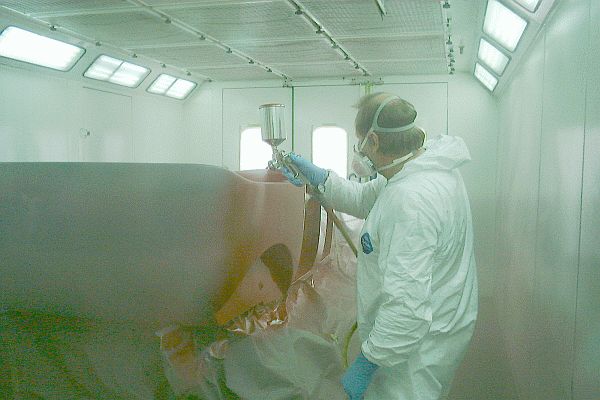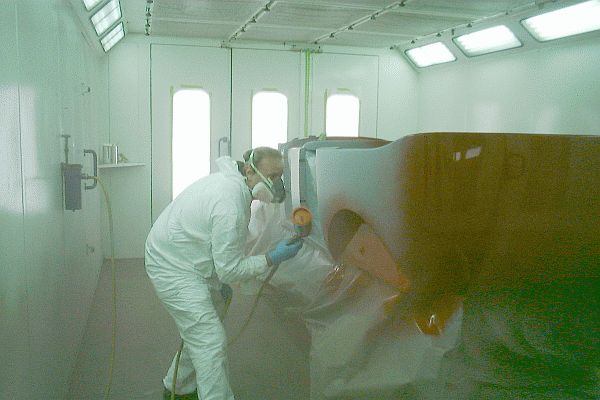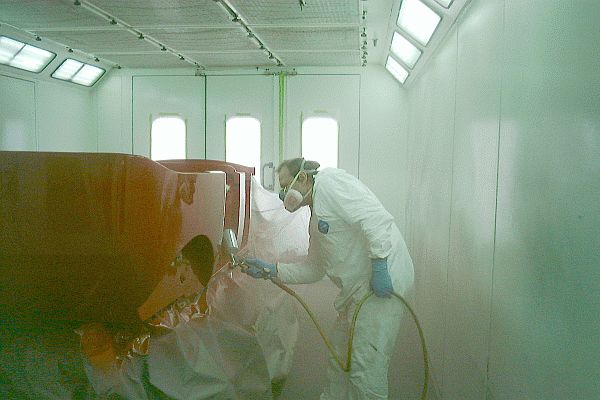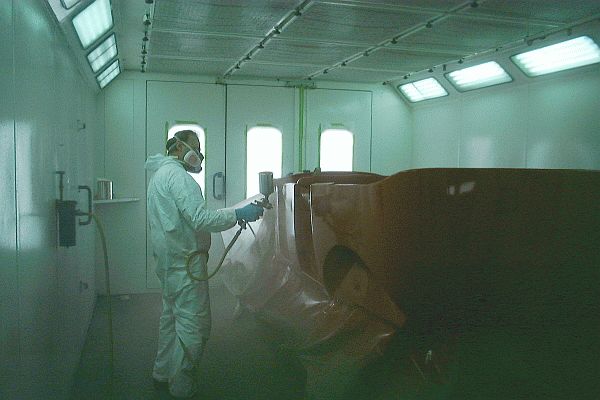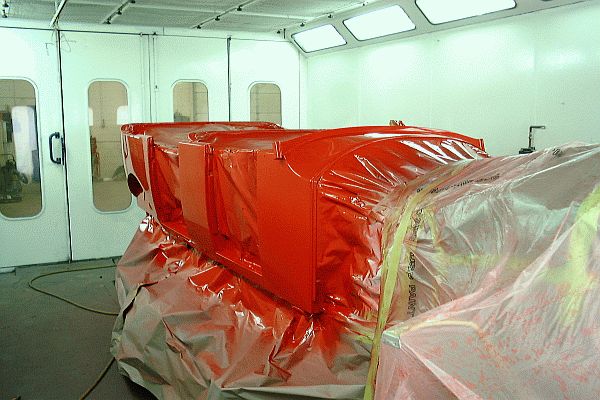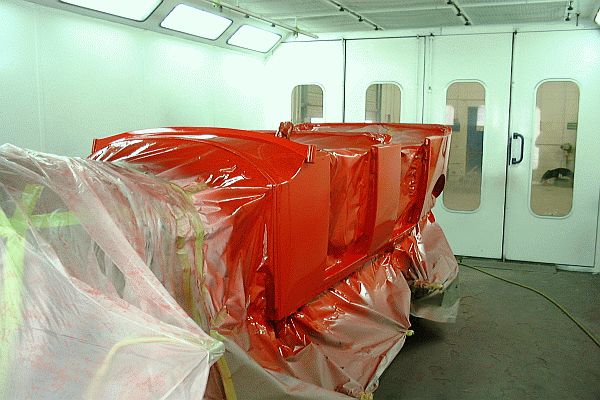|
With everything prepared, the top color coat is applied to the car. Starting at the top of a body section, the paint gun is moved right and left from the top of a section being painted down to the bottom of the section being painted. By painting from the top of a body section to the bottom the mist of paint droplets that do not make it onto the body panel are drawn down to the floor grate and do not have an opportunity to dull the wet surface of the car. The photos of the car being painted appear fuzzy as they were taken through the glass windows of the paint booth. While the red paint was being sprayed the interior of the booth also took on a red fog appearance of mist and vapors.
At the rear of the car the wheel well is painted first because of the irregular contours which exist. Anytime automotive paints are sprayed it is imperative to wear the proper personal protective dress. The use of a Tyvek coverall, latex gloves, and a respirator are required even with the high air exchange properties of the booth. As the car is painted you'll note how the filter on the respirator takes on a red tint of fine dust. Behind the filter is a chemical cartridge that absorbs the chemical vapors emitted by the paint as it is sprayed. The paint gun being used is a High Volume Low
Pressure (HVLP) gun. This style of gun is custom designed to apply the low
Volatile Organic Compound (VOC) paints that are now standard in the
automotive industry. The object of any paint spray gun is to break up
the primer/sealer/paint/clear into small particles and to place those
particles in uniform bands on the panel being coated. How good the
finish looks after the paint is dry atomized the paint droplets and moves
them to the panel being treated. The thinner (lower viscosity level) you get the material being sprayed, or the more air you have at the fluid tip of the gun, the more it breaks up the material being sprayed. If this balance is not right the finish will ultimately suffer. An experienced painter knows just what the perfect balance is depending on quite a number of variables which will influence the outcome. Too much solvent and the sprayed material will have no body, fill, durability, etc. Too much air and you blow the sprayed material everywhere but the car, and you'll have poor adhesion, excessive texture, etc.
In addition to the controlled environment that the paint booth provides, and the variables associated with the setup and operation of the paint gun, a host of other variables affect the outcome of the job. The air supply to the guy must be uniform in pressure, of low moisture content, and void of all oils or other materials. The mixing of fresh paint components must be done diligently and exactly to manufacturer's specifications and all have a "pot life" (time window they can be used after mixing). Once the first coat was applied the car was allowed to sit for 15 minutes while the paint started to dry to a tacky state. Once dry to a tacky state the second coat can be applied.
The second coat of color is applied over the previous coat. Applying the first coat is easy since the red color coat is being applied over the gray sealer coat. The second and third coats are much more difficult to apply since there's very little color difference between the paint color being applied and the paint color already on the car. In addition the first coat of paint hasn't fully cured and the heavy application of a second coat can cause sagging of the paint and other imperfections.
After the second coat dried for 15 minutes the third and final coat could be applied. For the final coat the red color was diluted to a 50% color and 50% clear mix. The clear coat contains an increased level of UV protectant and provides increased resistance for the top coat to the degrading effects of the sun.
With the third and final coat applied the car sits while the paint dries to a tack. Once the paint has started to dry the thermal baking qualities of the paint booth are brought into play. The air flowing through the booth is brought up to 140° Fahrenheit and held at this temperature for 40 minutes. This allows the paint to dry so that it can be touched (abet carefully) and the masking tape carefully removed from alongside painted areas.
Above the car has finished baking and the temperature of the paint booth is ramped back to ambient in order to cool the body surfaces. Once the painted surfaces are returned to ambient temperature the paper and tape is removed and the wheels put back on the car so that it can be rolled out of the paint booth. |
